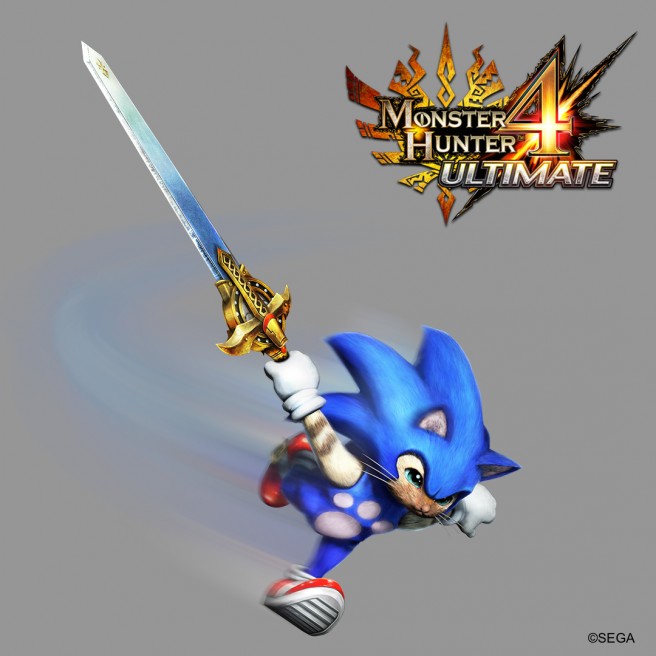Video: Ryozo Tsujimoto, Kaname Fujioka talk all about Monster Hunter 4 Ultimate
Posted on 10 years ago by Brian(@NE_Brian) in 3DS, Videos | 0 comments
Video: Monster Hunter 4 Ultimate – Ryozo Tsujimoto shares his top 3 monsters
Posted on 10 years ago by Brian(@NE_Brian) in 3DS, Videos | 1 Comment
Monster Hunter 4 Ultimate devs on lack of Wii U version, collaborations, support from Nintendo, and more
Posted on 10 years ago by Brian(@NE_Brian) in 3DS, New Nintendo 3DS, News, Wii U | 23 Comments
Another interview with Monster Hunter 4 Ultimate executive producer Ryozo Tsujimoto and creative director Kaname Fujioka has appeared, this time coming from Nintendo Life. The two developers tackled various topics such as the lack of a Wii U version, collaborations in the game, support received from Nintendo, and more. Check out some excerpts from the new interview below.
Monster Hunter games don’t have a “Desire Sensor” as some have speculated
Posted on 11 years ago by Brian(@NE_Brian) in 3DS, General Nintendo, News, Wii, Wii U | 6 Comments
Have you ever heard of something called the “Desire Sensor”? Those who have played the Monster Hunter titles have speculated about the sensor, which is programming within the games that can detect which loot players are searching for. The loot in question is then automatically made more difficult to find in order to keep gamers playing.
But no: there is no Desire Sensor in Monster Hunter. Series producer Ryozo Tsujimoto confirmed to Siliconera that this “feature” does not exist.
Tsujimoto said:
“You should probably wear gloves when you play. Try not to sweat, because it’s sensing your nervousness from the sweat on your hands. To be honest, that’s something that’s a popular urban legend. We actually hear that a lot, but it’s just a form of confirmation bias. When you’re looking for something specific, it feels like you never come across it. I myself experience that while playing—we’re all on an even playing field.”
“That (Desire Sensor) is absolutely not a thing. What people are seeing is just confirmation bias.”
More: interview, Monster Hunter, Ryozo Tsujimoto
Video: Monster Hunter 4 Ultimate producer Ryozo Tsujimoto gives a tour of Capcom’s TGS 2014 booth
Posted on 11 years ago by Brian(@NE_Brian) in 3DS, General Nintendo, Videos | 1 Comment
Monster Hunter 4 Ultimate producer explains Sonic and Nintendo collaborations
Posted on 11 years ago by Brian(@NE_Brian) in 3DS, News | 4 Comments
Monster Hunter 4 Ultimate is jam-packed with collaborations with other franchises. Recently, SEGA announced that the game would see a crossover with Sonic the Hedgehog. Players will be able to dress felynes in Sonic armor, and there’s also a guild card based on the Green Hill Zone.
Monster Hunter 4 Ultimate producer Ryozo Tsujimoto explained to Siliconera how the collaboration with SEGA came to be. He said:
“There are actually a few people at Sega that we’re pretty close to. We were chatting and thinking if there was something we could do together—some kind of collaboration. Then we settled on Sonic, ultimately, because he’s not only popular here in Japan, he’s also extremely popular overseas.”
“Since we’re doing an overseas version of this game, it made sense to do some sort of collaborative crossover that would make sense globally. So I had an associate of mine at Sega introduce me to the person in charge [of licensing]. We shook hands, made the deal, and there you go.”
Video: “Monster Hunter at Japan Expo 2014 – Interview with Ryozo and community”
Posted on 11 years ago by Brian(@NE_Brian) in 3DS, Videos | 0 comments
Monster Hunter 4 Ultimate devs on the Old Desert, online play, more
Posted on 11 years ago by Brian(@NE_Brian) in 3DS, News | 0 comments
Dengeki recently caught up with Monster Hunter 4 Ultimate producer Ryozo Tsujimoto and director Kaname Fujioka. One of the major topics discussed is the addition of the Old Desert area, which is a returning field but new to this version of the game.
Fujioka said of the Old Desert:
Monster Hunter producer on his impression of American players
Posted on 11 years ago by Brian(@NE_Brian) in General Nintendo, News | 7 Comments
Monster Hunter series producer Ryozo Tsujimoto dished on his impression of western players – primarily in America – as part of an interview with Siliconera.
Tsujimoto said that the original assumption was that they’d have a more aggressive playstyle. However, he learned that this wasn’t actually so and they were more careful like Japanese players.
Here’s Tsujimoto’s comments in full:
More: Capcom, Monster Hunter, Ryozo Tsujimoto
More Monster Hunter 4 Ultimate footage, details
Posted on 11 years ago by Brian(@NE_Brian) in 3DS, News | 1 Comment
Monster Hunter 4 Ultimate producer Ryozo Tsujimoto and director Kaname Fujioka recently held a stream for the 3DS game. You’ll find more footage above, and a wave of details below.
– Serlegios has golden scales
– Old Desert map features fast dunes and some parts with moving sand that pushes players standing on top
– Oasis area has monsters that go to rest once they get damaged
– The area also has a few palm trees
– You’ll be able to climb up the trees and jump from each one
– Game has an advanced jumping technique where the Charge Axe-wielding Fujioka jumped off the tip of a dune and Tsujimoto managed to Hammer-launch him in mid-air, which resulted in an extra high jump
– The Felyne shows some kind of signal prior to launching the player up to perform an air-attack on Rathalos
– Monster Hunter 4 Ultimate has a feature that lets you set an automatic notice whenever you place a large Barrel Bomb
– This option can also be switched off and on
– Messages can also be set for your deaths
